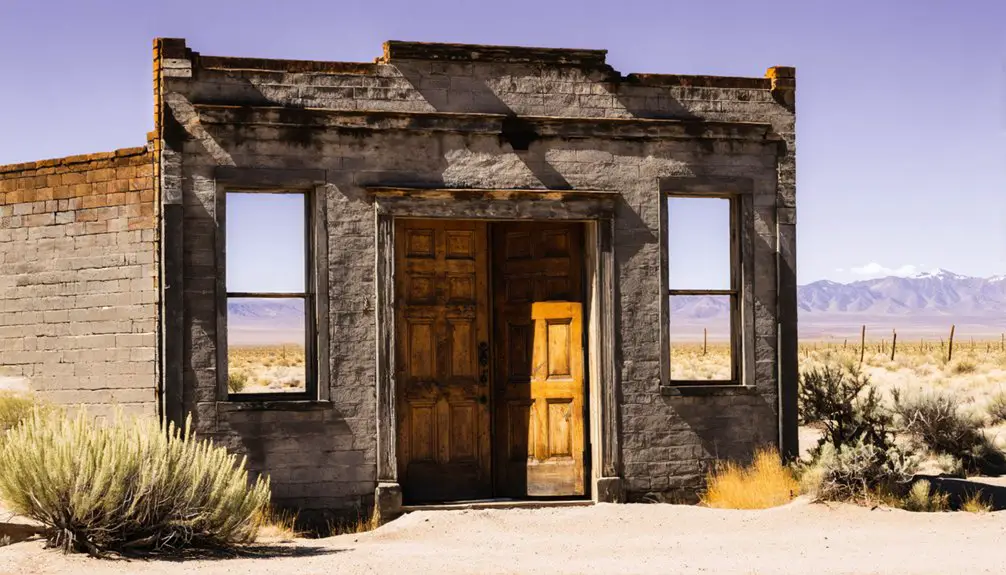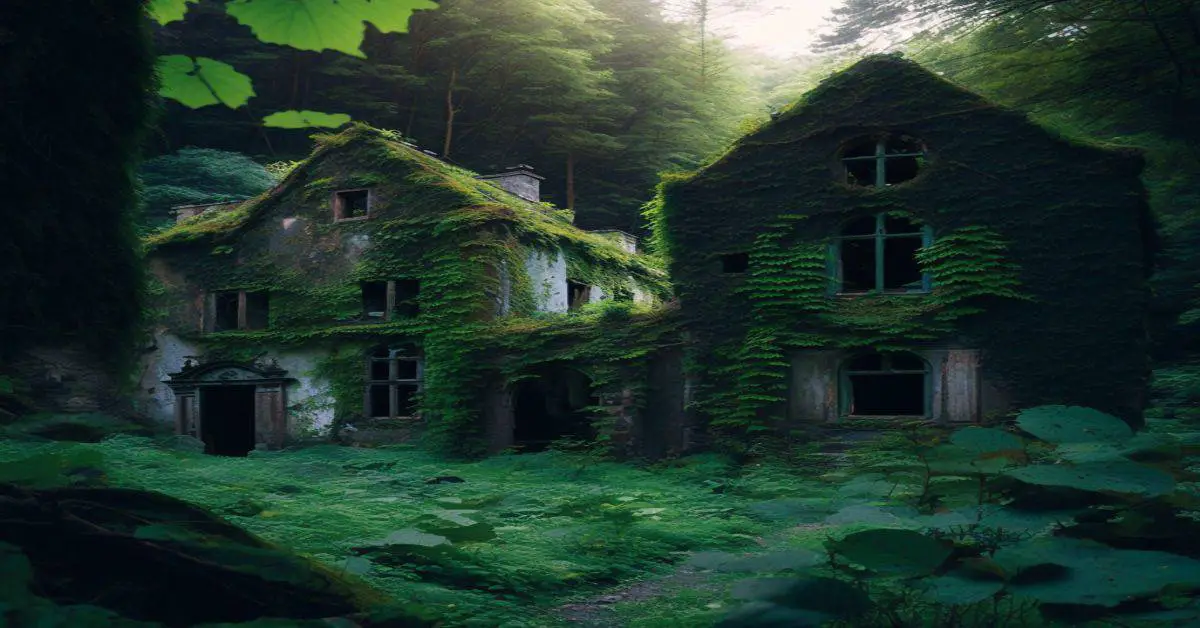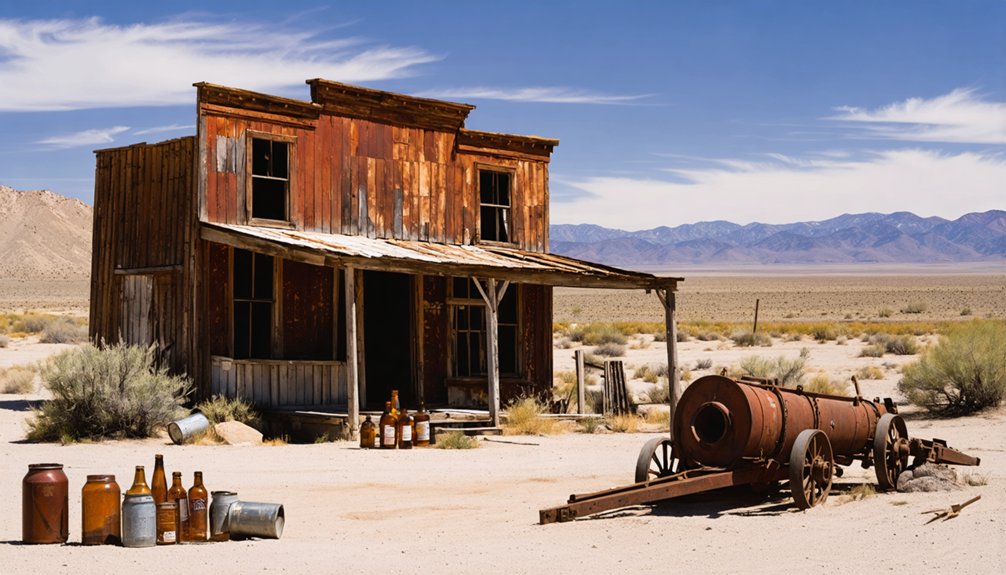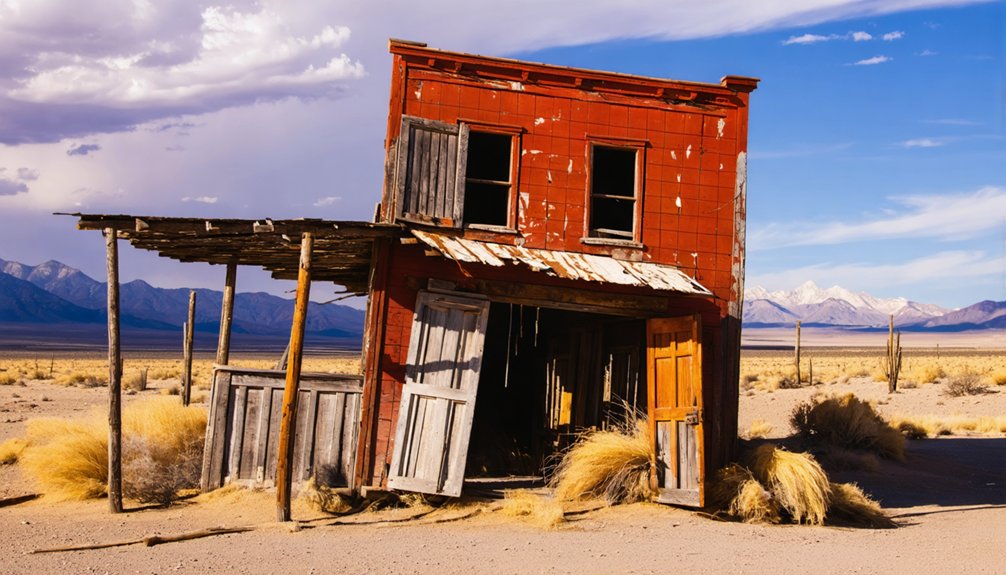You’ll find Rhyolite at Death Valley’s edge, where a stunning 1904 gold discovery transformed barren desert into a booming city of 8,000 residents. The town quickly developed modern amenities like electric lights, piped water, and three railroad connections. By 1908, it boasted an opera house, 50 saloons, and multiple churches. Yet within just three years, the Montgomery-Shoshone mine’s closure triggered Rhyolite’s dramatic downfall, leaving behind compelling ruins that tell an American boom-and-bust tale.
Key Takeaways
- Rhyolite was a Nevada gold mining boomtown that grew from nothing to 8,000-12,000 residents between 1904 and 1908.
- The town featured modern amenities including electric lights, water systems, telephones, and three railroad connections to major cities.
- The Montgomery-Shoshone Mine, owned by Charles M. Schwab, was the primary economic driver of Rhyolite’s rapid growth.
- Following the 1907 financial panic and declining ore values, Rhyolite’s population plummeted to fewer than 1,000 by 1909.
- By 1916, Rhyolite was abandoned after the mine’s closure, loss of essential services, and a devastating fire in 1908.
The Birth of a Desert Boomtown
When gold was discovered on Bullfrog Mountain in August 1904, it sparked one of Nevada’s most dramatic mining booms. You would’ve witnessed prospectors Cross and Harris revealing ore worth $3,000 per ton, triggering a gold rush that transformed empty desert into a bustling frontier metropolis.
Within months, Rhyolite emerged from a makeshift tent city into a structured settlement. Unlike typical wooden mining towns, you’d have seen buildings constructed of stone and concrete to withstand harsh desert conditions. The bustling town quickly grew to include over 5,000 residents by 1907. Three railroads connected the town to Las Vegas and Tonopah, establishing vital transportation links.
Early mining technology and infrastructure developments proved essential – particularly the completion of a water system in June 1905, which enabled the town’s explosive growth. By mid-1905, you’d have found yourself among 2,500 residents, complete with a substantial hotel, post office, and the beginnings of what would become Nevada’s most modern boomtown.
Life in the Golden Years
During Rhyolite’s golden years from 1907-1908, you’d have found yourself among 8,000-12,000 residents in what briefly became Nevada’s largest town. You could’ve enjoyed modern amenities rare for mining towns: electric streetlights, piped water, and telephone service. The concrete four-cell jail provided law enforcement for the bustling community.
The vibrant community engagement was evident in the town’s two newspapers, multiple churches, and public school. Citizens enjoyed recreational activities including symphony and baseball matches.
Cultural investments set Rhyolite apart from typical boomtowns. You’d have discovered an opera house, over 50 saloons, and sophisticated stone buildings instead of wooden structures.
The Montgomery-Shoshone mine fueled a robust economy, supporting banks, hotels, and diverse businesses. You could’ve traveled by stagecoach, touring car, or railroad, connecting you to major Nevada cities.
This progressive atmosphere attracted miners, merchants, entertainers, and professionals, creating a full-service desert community.
Building a City From Scratch
After the initial gold discoveries in early 1905, Rhyolite quickly transformed from a tent city into a meticulously planned settlement of 36 blocks.
The town’s urban planning showcased mining innovation at its finest, with lots given away to attract settlers who’d shape the community’s future. You’d have witnessed an incredible transformation as wooden and stone buildings replaced canvas shelters near the Montgomery-Shoshone mine. The bustling city soon featured fifty operating saloons to serve its growing population. The town boasted swimming pools with nightly water changes for its residents.
- Advanced water systems completed by mid-1905 brought reliable resources to residents
- Installation of 400 electric streetlights and telephone service by 1907 modernized daily life
- Three railroad lines connected you to Tonopah, Goldfield, and Las Vegas for seamless travel
The rapid infrastructure development, backed by Charles M. Schwab’s investments, turned this mining camp into a sophisticated city with concrete sidewalks and essential services uncommon in boom towns.
The Montgomery-Shoshone Legacy
The legendary Montgomery-Shoshone Mine, discovered in 1904 by prospectors Frank “Shorty” Harris and Ernest “Ed” Cross, would become the cornerstone of Rhyolite’s meteoric rise.
When Charles M. Schwab took over mine ownership in 1906, he transformed both the operation and the surrounding area through ambitious infrastructure investments. Initial ore values reached $16,000 per ton during peak production. The mine’s operations expanded rapidly with new shafts and tunnels.
You’ll find Schwab’s economic impact stretched far beyond the mine itself. Under his direction, Rhyolite blossomed with modern amenities including electricity, water mains, and three separate railroad connections.
The town’s population swelled to nearly 5,000 residents, supported by a thriving commercial district complete with a stock exchange and opera house.
However, the prosperity proved short-lived. By 1910, the mine operated at a loss, and its 1911 closure marked the beginning of Rhyolite’s swift decline into the ghost town you can explore today.
A Swift and Dramatic Decline
While Rhyolite’s explosive growth captivated investors and prospectors alike, its decline proved even more dramatic than its rise.
The population exodus began after 1908, plummeting from over 8,000 residents to fewer than 1,000 by 1909. The area’s geology featured silica-rich volcanic rock, reflecting the region’s ancient volcanic activity.
You’ll find the economic downturn was ruthlessly swift – triggered by the 1907 financial panic, overvalued mining stocks, and the exhaustion of rich ore veins.
- The Montgomery-Shoshone mine’s closure in 1911 dealt the fatal blow
- Essential services vanished by 1916, including electricity and rail transport
- A devastating fire in 1908 accelerated the town’s abandonment
Preserved Remnants in the Desert
Despite its rapid decline, Rhyolite’s physical legacy endures through remarkably preserved structures scattered across the desert landscape. You’ll find about a dozen buildings still standing, including the bank’s thick-walled vault, jail, train station, and the uniquely constructed Bottle House – built from 50,000 beer bottles and mud.
The architectural preservation of these remnants offers a glimpse into the town’s brief but prosperous era.
While most structures have crumbled or were salvaged, the remaining ruins hold significant historical significance as one of America’s best-preserved ghost towns. On-site caretakers protect the iconic Bottle House, and preservation efforts maintain the site’s authentic atmosphere. The town experienced a swift downfall after the mine closed in 1920, leaving behind these haunting ruins.
You can explore the original concrete sidewalks and building remnants that tell the story of a once-thriving desert boomtown.
Frequently Asked Questions
Is Rhyolite Safe to Visit at Night?
You shouldn’t attempt nighttime exploration – it’s illegal and unsafe. The ghost town safety risks include unstable structures, wildlife, cold temperatures, poor visibility, and no emergency services if you’re injured.
What Paranormal Activity Has Been Reported in Rhyolite?
Keeping you on your toes, ghostly sightings include EVP recordings at Mona Belle’s grave, apparitions in abandoned buildings, unexplained sounds at the bottle house, and eerie encounters throughout the haunted history of town ruins.
How Much Gold Remains Unmined in the Rhyolite Area Today?
You’ll find no definitive data on remaining gold quantities, though unexplored mines and active drilling near Rhyolite Ridge suggest untapped gold prospects. Current exploration focuses more on lithium-boron deposits than precious metals.
Where Did Most of Rhyolite’s Residents Relocate After Abandoning the Town?
During the town’s economic decline, nearly 80% of residential migration flowed to nearby Beatty, Nevada. You’ll find that most former residents chose Beatty because it offered jobs and maintained rail connections.
What Items Can Visitors Legally Collect as Souvenirs From Rhyolite?
You can’t legally collect historic items or artifacts as souvenirs. Your only collectible items are photos you take and legitimate souvenirs purchased from nearby Beatty’s authorized gift shops.
References
- https://www.nvexpeditions.com/nye/rhyolite.php
- https://www.exploratography.com/blog-nv/rhyolite-nevada
- https://www.moon.com/travel/trip-ideas/ghost-town-rhyolite-death-valley/
- https://en.wikipedia.org/wiki/Rhyolite
- https://ladailypost.com/posts-from-the-road-rhyolite-ghost-town-in-nevada/
- https://www.legendsofamerica.com/nv-rhyolite/
- https://westernmininghistory.com/towns/nevada/rhyolite/
- https://www.rhyoliteghosttownnevada.org/explore/rhyolite-ghost-town
- https://travelnevada.com/ghost-town/rhyolite-ghost-town/
- https://nvtami.com/2025/01/27/rhyolite-ghost-town-nevadas-diamond-in-the-desert/



